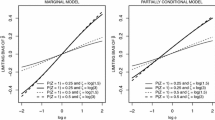Abstract
Chronic disease processes often feature transient recurrent adverse clinical events. Treatment comparisons in clinical trials of such disorders must be based on valid and efficient methods of analysis. We discuss robust strategies for testing treatment effects with recurrent events using methods based on marginal rate functions, partially conditional rate functions, and methods based on marginal failure time models. While all three approaches lead to valid tests of the null hypothesis when robust variance estimates are used, they differ in power. Moreover, some approaches lead to estimators of treatment effect which are more easily interpreted than others. To investigate this, we derive the limiting value of estimators of treatment effect from marginal failure time models and illustrate their dependence on features of the underlying point process, as well as the censoring mechanism. Through simulation, we show that methods based on marginal failure time distributions are shown to be sensitive to treatment effects delaying the occurrence of the very first recurrences. Methods based on marginal or partially conditional rate functions perform well in situations where treatment effects persist or in settings where the aim is to summarizee long-term data on efficacy.






Similar content being viewed by others
References
Aalen OO (1978) Nonparametric inference for a family of counting processes. Ann Stat 6:701–726
Andersen PK, Gill R (1982) Cox’s regression model for counting processes: a large sample study. Ann Stat 10:1100–1120
Cook RJ, Lawless JF (2003) Cumulative processes related to event histories. SORT 27:13–30
Cox DR (1972) Regression models with lifetables (with discussion). J Roy Stat Soc Ser B 34:187–220
Cox DR (1975) Partial likelihood. Biometrika 62:269–276
Daley DJ, Vere-Jones D (1988) An introduction to the theory of point processes. Springer, New York
Datta S, Satten GA (2001) Validity of the Aalen–Johansen estimators of stage occupation probabilities and Nelson–Aalen estimators of integrated transition hazards for non-Markov models. Stat Probabil Lett 55:403–411
Glasziou PP, Simes RJ, Gelber RD (1990) Quality adjusted survival analysis. Stat Med 9:1259–1276
Kalbfleisch JD, Prentice RL (2002) The statistical analysis of failure time data, 2 edn. Wiley, New York
Kelly PJ, Lim LLY (1999) Survival analysis for recurrent event data: an application to childhood infectious diseases. Stat Med 19:13–33
Kong FH, Slud E (1997) Robust covariate-adjusted logrank tests. Biometrika 84:847–862
Lagakos SW (1988) The loss in efficiency from misspecifying covariates in proportional hazards regression models. Biometrika 75:156–160
Lagakos SW, Schoenfeld DA (1984) Properties of proportional-hazards score tests under misspecified regression models. Biometrics 40:1037–1048
Lawless JF (1995) The analysis of recurrent events for multiple subjects. Appl Stat 44:487–498
Lawless JF (2003) Statistical models and methods for lifetime data. John Wiley and Sons, New York
Lawless JF, Nadeau JC (1995) Some simple robust methods for the analysis of recurrent events. Technometrics 37:158–168
Lawless JF, Thiagarajah K (1996) A point process model incorporating renewals and time trends. Technometrics 38:131–138
Lee EW, Wei LJ, Amato DA (1992) Cox-type regression analysis for large numbers of small groups of correlated failure time observations. In: Klein JP, Goel PK (eds) Survival analysis: state of the art. Kluwer, New York, pp 237–247
Lin DY (1994) Cox regression analysis of multivariate failure time data: the marginal approach. Stat Med 13:2233–2247
Lin DY, Wei LJ (1989) The robust inference for the Cox proportional hazards model. J Am Stat Assoc 84:1074–1078
Lin DY, Sun W, Ying Z (1999) Nonparametric estimation of the gap time distribution for serial events with censored data. Biometrika 86:59–70
Lin DY, Wei LJ, Yang I, Ying Z (2000) Semiparametric regression for the mean and rate functions of recurrent events. J Roy Stat Soc B 62:711–730
Nelson WA (1995) Confidence limits for recurrence data – applied to cost or number of product repairs. Technometrics 37:147–157
North American Symptomatic Carotid Endarterectomy Trial Collaborators (1991) Beneficial effect of carotid endarterectomy in symptomatic patients with high-grade carotid stenosis. New England J Med 325:445–453
Oakes D (1997) Discussion of the paper by Wei and Glidden. Stat Med 16:843
Pepe MS, Cai J (1993) Some graphical displays and marginal regression analyses for recurrent failure times and time-dependent covariates. J Am Stat Assoc 88:811–823
Prentice RL, Williams BJ, Peterson AV (1981) On the regression analysis of multivariate failure time data. Biometrika 68:373–379
Strawderman R (2000) Estimating the mean of an increasing stochastic process at a censored stopping time. J Am Stat Assoc 2000 95:1192–1208
Struthers CA, Kalbfleisch JD (1986) Misspecified proportional hazards models. Biometrika 73:363–369
Therneau TM, Grambsch PM (2000) Modeling survival data: extending the Cox model. Springer, New York
Therneau TA, Hamilton SA (1997) rhDNase as an example of recurrent event analysis. Stat Med 16:2029–2047
Wei LJ, Lin DY, Weissfeld L (1989) Regression analysis of multivariate incomplete failure time data by modeling marginal distributions. J Am Stat Assoc 84:1065–1073
Acknowledgements
This research was supported by the Natural Sciences and Engineering Research Council and the Canadian Institutes for Health Research.
Author information
Authors and Affiliations
Corresponding author
Rights and permissions
About this article
Cite this article
Boher, J., Cook, R.J. Implications of Model Misspecification in Robust Tests for Recurrent Events. Lifetime Data Anal 12, 69–95 (2006). https://doi.org/10.1007/s10985-005-7221-8
Received:
Accepted:
Issue Date:
DOI: https://doi.org/10.1007/s10985-005-7221-8




